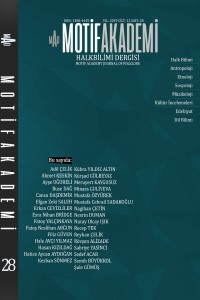Öz
In this study, the data about the image of Christianity was
determined and evaluated from the examples chosen from the legend, religious
legend, epic, folk story and jokes which are the oral narrative types of
Turkish society. Christian image is dealt with its body, place, moral
qualities, and the relationship between the main heroes in the narratives and
discussed through the characteristics of the image and the functions undertaken
in the narrative. It can be said that the Christian image finds its place in
the Turkish narrative tradition more gloriously than the images of otherness
that can be included in other religious clusters. In addition, it is possible
to say that the image in question is concentrated especially in examples where
the theme of conflict is intensively studied, such as the epic, and in the
genres such as the Religious legend, which becomes evident for the organization
of religious identity. It can be said that the pejorative qualities of the
Christian image, which is regarded as dreadful and dangerous in connection with
symbolic pollution, contribute to the positioning of the struggle that the
producer and consumer of the narratives will engage with the opposing group on
a legitimate basis. Parallel to this, it can be added that the Christian image
in the Turkish narrative tradition is instrumentalized in terms of showing
ideas about the positive qualities of Muslims.
Anahtar Kelimeler
Kaynakça
- Ahmet Eflaki, (1973). Ariflerin Menkıbeleri I, (çev: Tahsin Yazıcı), İstanbul: Hürriyet Yayınları.
- Ahmet Eflaki, (1973b). Ariflerin Menkıbeleri II, (çev: Tahsin Yazıcı), İstanbul: Hürriyet Yayınları.
- BORATAV, Pertev Naili (1969). Az Gittik Uz Gittik, Ankara: Bilgi Yayınevi.
- BORATAV Pertev Naili (2006). Nasreddin Hoca. İstanbul: Kırmızı Yayınları.
- DEMİR, Necati (2004). Danişmend-Nâme, Ankara: Akçağ Yayınları.
- DEMİR, Necati (2006). Battalnâme (Eski Türkiye Türkçesi), Ankara: Hece Yayınları.
- DEMİR, Necati (2007a). Hazret-i Ali Cenkleri, Ankara, Destan Yayınları.
- DEMİR, Necati (2007b). Saltık-Name, Ankara: Destan Yayınları.
- ELİADE, Mircea (1994). Ebedi Dönüş Mitosu, (çev: Ümit Altuğ), Ankara: İmge Kitabevi.
- ERGUN, Metin (1997). Türk Dünyası Efsanelerinde Değişme Motifi, Ankara: TDK Yayınları.
- Firdevsi, (2009). Şehnâme, (çev: Necati Lugal), İstanbul: Kabalcı Yayınları.
- GIRARD, René (2005). Günah Keçisi, (çev: Işık Ergüden), İstanbul: Kanat Kitap.
- GÖLPINARLI, Abdülbaki (1958). Menakıb-ı Hacı Bektaş-ı Veli: Vilâyet-Nâme, İstanbul: İnkılap Yayınevi.
- GÜZEL, Abdurrahman (1999). Kaygusuz Abdal (Alâeddin Gaybi), Ankara: TTK Yayınları.
- Homeros, (2008). Odysseia, (çev: A. Erhat ve A. Kadir), İstanbul: Can Yayınları.
- MİLLAS, Herkül (2000). Türk Romanı ve Öteki: Ulusal Kimlikte Yunan İmajı, İstanbul: Sabancı Üniversitesi Yayınları.
- OKUMUŞ, Ejder (2011). “Bedene Müdahalenin Sosyolojisi”, Beden Sosyolojisi, (ed: Kadir Canatan), İstanbul: Açılımkitap.
- ÖZÇELİK, Sadettin (2013) “Dede Korkut Eydür: ‘Oğul Ol Nesne Tarıglık Degül Tar Kıllıkdur Ol Fi’l Boşalmak Degül Yoşulmak’dur”, Uluslararası Türkçe Edebiyat Kültür Eğitim Dergisi, S: 2/3, ss: 47-52.
- SEYİDOĞLU, Bilge (2005). Erzurum Efsaneleri, İstanbul: Dergâh Yayınları.
- TEZCAN, Semih ve BOESCHOTEN, Hendrik (2001). Dede Korkut Oğuznâmeleri, İstanbul: YKY.
- YAVUZ, Muhsine Helimoğlu (2013). .Diyarbakır Efsaneleri, Ankara: Eğiten Kitap.
- YILDIRIM, Dursun (1998).Türk Bitiği, Ankara: Akçağ Yayınları.
Öz
Bu çalışmada Türk
toplumunun sözlü anlatı türleri olan efsane, menkıbe, destan, halk hikâyesi ve
fıkra örnekleri içerisinde yer alan Hıristiyan imajına dair veriler saptanarak
değerlendirilmiştir. Hıristiyan imajı; beden, mekân, ahlaki nitelikler ve
anlatılardaki asıl kahramanlarla kurulan ilişki biçimleri üzerinden ele alınmış
ve söz konusu imajın anlatıda üstlendiği işlevlere ulaşılması hedeflenmiştir. Hıristiyan
imajının, diğer dinsel kümelere dâhil edilebilecek ötekiliğe dair imajlara
nazaran daha görkemli bir biçimde Türk anlatı geleneği içerisinde kendine yer
bulduğu söylenebilir. Bunun yanında söz konusu imajın özellikle destan gibi
çatışma temasının yoğun olarak işlendiği örneklerde ve dinsel kimliğin
örgütlenmesi amacı ile belirginleşen menkıbe gibi türlerde yoğunlaştığını
söylemek mümkündür. Sembolik bir kirlilikle bağıntılı olarak korkunç ve
tehlikeli kabul edilen Hıristiyan imajının pejoratif niteliklerinin,
anlatıların üreticisi ve tüketicisi olan kitlenin karşıt grupla girişeceği
mücadelenin meşru bir zemine konumlandırılmasına katkı sağladığı söylenebilir.
Buna koşut olarak Türk anlatı geleneğindeki Hıristiyan imajının Müslümanların
olumlu niteliklerine dair fikirlerin gösterilmesi açısından araçsallaştırıldığı
da eklenebilir.
Anahtar Kelimeler
Kaynakça
- Ahmet Eflaki, (1973). Ariflerin Menkıbeleri I, (çev: Tahsin Yazıcı), İstanbul: Hürriyet Yayınları.
- Ahmet Eflaki, (1973b). Ariflerin Menkıbeleri II, (çev: Tahsin Yazıcı), İstanbul: Hürriyet Yayınları.
- BORATAV, Pertev Naili (1969). Az Gittik Uz Gittik, Ankara: Bilgi Yayınevi.
- BORATAV Pertev Naili (2006). Nasreddin Hoca. İstanbul: Kırmızı Yayınları.
- DEMİR, Necati (2004). Danişmend-Nâme, Ankara: Akçağ Yayınları.
- DEMİR, Necati (2006). Battalnâme (Eski Türkiye Türkçesi), Ankara: Hece Yayınları.
- DEMİR, Necati (2007a). Hazret-i Ali Cenkleri, Ankara, Destan Yayınları.
- DEMİR, Necati (2007b). Saltık-Name, Ankara: Destan Yayınları.
- ELİADE, Mircea (1994). Ebedi Dönüş Mitosu, (çev: Ümit Altuğ), Ankara: İmge Kitabevi.
- ERGUN, Metin (1997). Türk Dünyası Efsanelerinde Değişme Motifi, Ankara: TDK Yayınları.
- Firdevsi, (2009). Şehnâme, (çev: Necati Lugal), İstanbul: Kabalcı Yayınları.
- GIRARD, René (2005). Günah Keçisi, (çev: Işık Ergüden), İstanbul: Kanat Kitap.
- GÖLPINARLI, Abdülbaki (1958). Menakıb-ı Hacı Bektaş-ı Veli: Vilâyet-Nâme, İstanbul: İnkılap Yayınevi.
- GÜZEL, Abdurrahman (1999). Kaygusuz Abdal (Alâeddin Gaybi), Ankara: TTK Yayınları.
- Homeros, (2008). Odysseia, (çev: A. Erhat ve A. Kadir), İstanbul: Can Yayınları.
- MİLLAS, Herkül (2000). Türk Romanı ve Öteki: Ulusal Kimlikte Yunan İmajı, İstanbul: Sabancı Üniversitesi Yayınları.
- OKUMUŞ, Ejder (2011). “Bedene Müdahalenin Sosyolojisi”, Beden Sosyolojisi, (ed: Kadir Canatan), İstanbul: Açılımkitap.
- ÖZÇELİK, Sadettin (2013) “Dede Korkut Eydür: ‘Oğul Ol Nesne Tarıglık Degül Tar Kıllıkdur Ol Fi’l Boşalmak Degül Yoşulmak’dur”, Uluslararası Türkçe Edebiyat Kültür Eğitim Dergisi, S: 2/3, ss: 47-52.
- SEYİDOĞLU, Bilge (2005). Erzurum Efsaneleri, İstanbul: Dergâh Yayınları.
- TEZCAN, Semih ve BOESCHOTEN, Hendrik (2001). Dede Korkut Oğuznâmeleri, İstanbul: YKY.
- YAVUZ, Muhsine Helimoğlu (2013). .Diyarbakır Efsaneleri, Ankara: Eğiten Kitap.
- YILDIRIM, Dursun (1998).Türk Bitiği, Ankara: Akçağ Yayınları.
Ayrıntılar
| Birincil Dil | Türkçe |
|---|---|
| Konular | Türk Halk Bilimi |
| Bölüm | Makaleler |
| Yazarlar | |
| Yayımlanma Tarihi | 20 Aralık 2019 |
| Gönderilme Tarihi | 13 Ekim 2019 |
| Yayımlandığı Sayı | Yıl 2019 Cilt: 12 Sayı: 28 |


